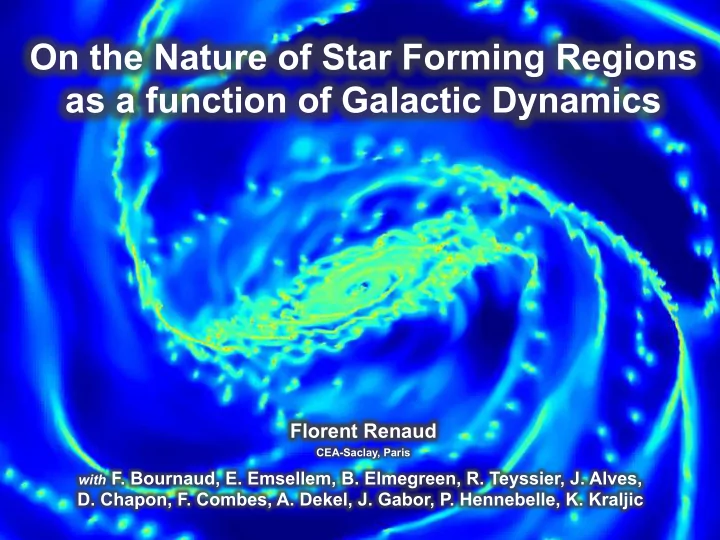

On the Nature of Star Forming Regions as a function of Galactic Dynamics Florent Renaud CEA-Saclay, Paris with F. Bournaud, E. Emsellem, B. Elmegreen, R. Teyssier, J. Alves, D. Chapon, F. Combes, A. Dekel, J. Gabor, P. Hennebelle, K. Kraljic
Kennicutt+(1998) Kennicutt+(2007) high-z starbursting mergers Bigiel+(2008) Tacconi+(2010) ; Daddi+(2010a) low-z starbursting Kennicutt+(1998) mergers high-z disks Bouché+(2007) ; Bothwell+(2009) Bolatto+(2011) local spirals SMC widely inspired by Daddi+ (2010b) (see also Genzel+ 2010)
Dependence on high-z starbursting à turbulence mergers (Mach number) low-z à metallicity starbursting (cooling) mergers high-z disks local spirals SMC Renaud, Kraljic & Bournaud (2012)
redshift galaxy-galaxy interaction(s) (intrinsic) galaxy evolution galaxy structure
Resolving star forming cores, in the galactic context cores: 0.01 pc galaxy: 100 kpc 7 orders of magnitude in space AND time How: self-consistent simulation of a galaxy, at subparsec resolution M31
maps 200 billion pixels (183,251,238,912 to be exact!) ¡ h t t p : / / i r f u . c e a . f r / P i s p / f l o r e n t . r e n a u d / m w . p h p
Renaud et al. (arXiv:1307.5639) stars gas RAMSES Teyssier et al. (2002) resolution: 0.05 pc Dubois & Teyssier (2008) Teyssier et al. (2013) 60M particles (DM + stars) Renaud et al. (2013) star formation + feedback (H II + radiation pressure + SNe)
Fragmenting spiral ¡ Formation of beads on a string within 10-15 Myr ¡ R θ 740 Myr 748 Myr 755 Myr
M83 NGC 628 Foyle et al. (2013) Gusev & Efremov (2013) see also Elmegreen & Elmegreen (1983)
σ ? = σ gas ≈ 10 km / s when stars form: ¡ σ ? ≈ 15 km / s 10 Myr later: ¡ (relaxation...) ¡ σ gas ≈ 9 km / s (dissipation...) ¡ v 2 rotation ≈ v 2 circular − σ 2 Binney & Tremaine (1987, p326)
Decoupling star-gas ¡ SN progenitors lag behind the cloud ¡ Asymmetric, offset feedback ¡ Inefficient at destroying clouds ¡
Kelvin-Helmholz instabilities M 51 Chakrabarti et al. (2003) Wada & Koda (2004) Kim & Ostriker (2006) Shetty & Ostriker (2006) Exist in 3D models (without MHD) Dobbs & Bonnell (2006) On the leading side of spirals Surface density 5 Myr older spurs spurs in formation (horizontal) Velocity
Schinnerer et al. (2013)
young old
small pitch angle strong velocity gradient: KH instabilities large pitch angle weak velocity gradient: no KH instabilities Renaud et al. (2013b) see Wada & Koda (2004) for an analytical approach
Shear Cloud-cloud collisions Tidal features SF enhancement in complexes ¡ Tasker & Tan (2009) Fukui et al. (2013)
Emsellem, Renaud et al. (in prep.) 1 kpc
Beads on a string = clustered star formation Spurs from KH instabilities = SF on leading side of spirals Assymetric drift = offset, less efficient feedback Disk dynamics (shear, pitch angle etc) set the conditions for star formation Several environments for SF found in the same disk Galactic dynamics matter to star formation! Down to what scale?
Recommend
More recommend